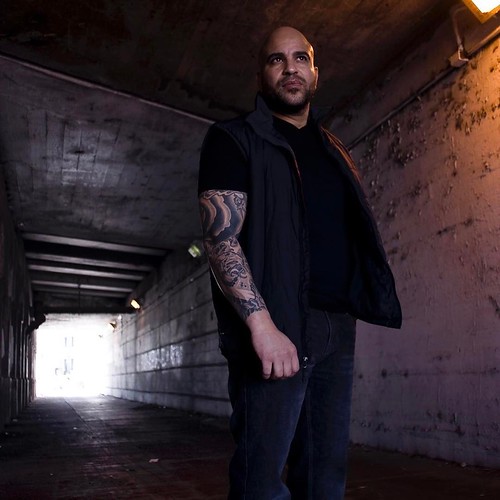able course of GA-I. Materials and Methods Chemicals Dulbecos modified Eagle’s  medium, Neurobasal medium, glutamine, B27, fetal bovine serum, penicillin/ streptomycin, trypsin, Fluoro JadeC, 5,59,6,69-tetrachloro1,19,3,39-tetraethylbenzimidazolylcarbocyanine iodide, 5-carboxy-29,79-difluorodihydrofluorescein diacetate and monochlorobimane were purchased from Invitrogen. Iron porphyrins came from 7 June 2011 | Volume 6 | Issue 6 | e20831 glial precursors leading to an increased immature astrogliogenesis has also been proposed as a mechanism for abnormal neuronal organization and survival in postnatal development. In addition, an exacerbated proliferation of astrocytes could impair the generation of oligodendrocytes from common glial precursors, contributing to white matter defects described in GA-I patients. Since S100b protein is typically secreted by astrocytes, its GA-induced expression could explain astrocyte proliferation and abnormal Astrocyte Damage and Striatal Degeneration Alexis Biochemical. 1,4-diamino-2,3dicyano-1,4-bis butadiene was purchased from Cell Signaling Technology. Commercial antibodies came from Dako, Chemicon, Sigma, Covance, Cell Signalling and Invitrogen. All other chemicals of analytical grade were obtained from Sigma. Ethical statement This study was carried out in strict accordance with the IIBCE Bioethics Committee’s requirements and under the current ethical regulations of the National law for animal experimentation Nu 18.611 that follows the Guide for the Care and Use of Laboratory Animals of the National Institutes of Health. All surgery was performed under ketamine:xilacine anesthesia, and all efforts were made to minimize suffering, discomfort or stress. All efforts were also made in order to use the minimal number of animals necessary to produce reliable scientific data. Animals Sprague Dawley rats, breeded at the IIBCE animal house, were maintained with food and water ad libitum, controlled temperature and 12 h light/dark cycle. 5 whole litters of 12 animals each were used for each experimental in vivo condition. Other 5 whole litters were employed for culturing astrocytes or neurons. All experiments were performed at least three times in duplicates or triplicates. demonstration of S100b, GFAP or NeuN as a pan-neuronal labeling. Neurofilament and phosphorylated neurofilament staining was made after citrate antigen retrieval as indicated by antibody manufacturers. In all cases, brain sections were washed in PBS and incubated with nonspecific binding blocking buffer for 30 min. Afterwards, sections were incubated overnight at 4uC with pairs of compatible antibodies such as a polyclonal buy Foretinib anti-rabbit GFAP together with monoclonal anti-S100b, anti-NeuN; or anti-68 kDa or antiphosphorylated thick neurofilaments. After primary antibody incubations, sections were rinsed in PBS, and then incubated at 10484070 room temperature for 90 min with either anti-mouse or anti-rabbit Ig conjugated to fluorescent probes, both diluted 1:500:800 in PBS-0.3% Triton. Sections were washed, mounted in glycerol and imaged in a FV300 Olympus confocal microscope. As negative controls, the primary antibodies were omitted. BrdU was recognized by using a mouse specific antibody after HCl denaturation and neutralization. Some BrdU immunostainings were recognized by a secondary antibody conjugated to horse radish peroxidase and diaminobenzidine stain. Nitrotyrosine recognition was made according to the protocol described above after a heat anti
medium, Neurobasal medium, glutamine, B27, fetal bovine serum, penicillin/ streptomycin, trypsin, Fluoro JadeC, 5,59,6,69-tetrachloro1,19,3,39-tetraethylbenzimidazolylcarbocyanine iodide, 5-carboxy-29,79-difluorodihydrofluorescein diacetate and monochlorobimane were purchased from Invitrogen. Iron porphyrins came from 7 June 2011 | Volume 6 | Issue 6 | e20831 glial precursors leading to an increased immature astrogliogenesis has also been proposed as a mechanism for abnormal neuronal organization and survival in postnatal development. In addition, an exacerbated proliferation of astrocytes could impair the generation of oligodendrocytes from common glial precursors, contributing to white matter defects described in GA-I patients. Since S100b protein is typically secreted by astrocytes, its GA-induced expression could explain astrocyte proliferation and abnormal Astrocyte Damage and Striatal Degeneration Alexis Biochemical. 1,4-diamino-2,3dicyano-1,4-bis butadiene was purchased from Cell Signaling Technology. Commercial antibodies came from Dako, Chemicon, Sigma, Covance, Cell Signalling and Invitrogen. All other chemicals of analytical grade were obtained from Sigma. Ethical statement This study was carried out in strict accordance with the IIBCE Bioethics Committee’s requirements and under the current ethical regulations of the National law for animal experimentation Nu 18.611 that follows the Guide for the Care and Use of Laboratory Animals of the National Institutes of Health. All surgery was performed under ketamine:xilacine anesthesia, and all efforts were made to minimize suffering, discomfort or stress. All efforts were also made in order to use the minimal number of animals necessary to produce reliable scientific data. Animals Sprague Dawley rats, breeded at the IIBCE animal house, were maintained with food and water ad libitum, controlled temperature and 12 h light/dark cycle. 5 whole litters of 12 animals each were used for each experimental in vivo condition. Other 5 whole litters were employed for culturing astrocytes or neurons. All experiments were performed at least three times in duplicates or triplicates. demonstration of S100b, GFAP or NeuN as a pan-neuronal labeling. Neurofilament and phosphorylated neurofilament staining was made after citrate antigen retrieval as indicated by antibody manufacturers. In all cases, brain sections were washed in PBS and incubated with nonspecific binding blocking buffer for 30 min. Afterwards, sections were incubated overnight at 4uC with pairs of compatible antibodies such as a polyclonal buy Foretinib anti-rabbit GFAP together with monoclonal anti-S100b, anti-NeuN; or anti-68 kDa or antiphosphorylated thick neurofilaments. After primary antibody incubations, sections were rinsed in PBS, and then incubated at 10484070 room temperature for 90 min with either anti-mouse or anti-rabbit Ig conjugated to fluorescent probes, both diluted 1:500:800 in PBS-0.3% Triton. Sections were washed, mounted in glycerol and imaged in a FV300 Olympus confocal microscope. As negative controls, the primary antibodies were omitted. BrdU was recognized by using a mouse specific antibody after HCl denaturation and neutralization. Some BrdU immunostainings were recognized by a secondary antibody conjugated to horse radish peroxidase and diaminobenzidine stain. Nitrotyrosine recognition was made according to the protocol described above after a heat anti